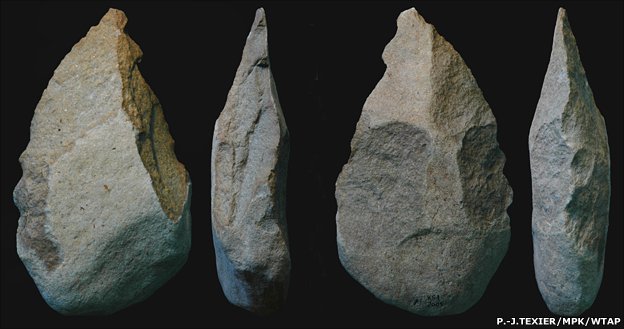Researchers tell the journal Nature that the tools were probably made by the human ancestor Homo erectus.
This was a bigger-brained, smarter and more dextrous creature than any human species before it.
Homo erectus ranged across Africa and Asia before going extinct about 70,000 years ago. Many suspect it was on the direct evolutionary line to modern humans - Homo sapiens.
Careful design
Palaeolithic stone tools can be grouped into a number of different styles. The type unearthed at the Kokiselei archaeological site is referred to by anthropologists as Acheulian technology.
Such objects are larger and heavier than the pebble-choppers (Oldowan technology) that were used previously and which are associated with a more primitive human known as Homo habilis.
The Acheulian hand-axes also have distinctive chiselled edges.
Manufacturing them would have required forethought in design and the careful selection of particular types of starting rocks from which to fashion the final product.
"The Oldowan is a little more haphazardly made," said lead author Christopher Lepre from Rutgers University and Columbia University's Lamont-Doherty Earth Observatory.
"It's not until you start seeing Acheulian culture do you get into tools that are very systematic and more recognisable to the lay person as tools," he told the BBC.
Magnetic dates
The Kokiselei objects were dated by analysing the mudstone sediments in which they were found.
The tools were recovered from ancient shoreline sediments close to modern-day Lake Turkana
Mudstones contain iron minerals that preserve the direction of the Earth's magnetic field at the time they were laid down - a tell-tale signature that can be compared with a range of other palaeo-records to reveal an age.
The study reported in Nature shows the tools were in use some 350,000 years earlier than all previous Acheulian finds.
This dating places them closer to the origins of Homo erectus, and suggests the Acheulian was the proprietary technology of this specific human species, said Dr Lepre.
"Our finding does suggest that the Acheulian was indeed invented nouveau by Homo erectus.
"There probably wasn't that period of borrowing from Homo habilis, meaning that once Homo erectus had originated, they invented this new tool technology - the Acheulian hand-axe."
Great migration
If Homo erectus originated in Africa and then spread out across Asia, the puzzle is why the species did not take the more advanced Acheulian capability with it immediately - it is hundreds of thousands of years before the technology becomes more widespread elsewhere in the world.
"If Homo erectus has the technology and has evolved the behaviour this early - why not see it right away [out of Africa]? pondered Rhonda Quinn from Rutgers University in New Jersey, US.
"Why didn't this advanced technology aid the dispersal, to tap into new environments? Why the delay?
"Is it because the hominins that actually dispersed were not the Acheulian users?
"Whether that means a species difference, or just a cultural difference - that's something we can now go and test," she told BBC News.
Liverpool University's John Gowlett, who was not connected with the study, said Dr Lepre's team had done an excellent job "to nail a date that is probably earlier than we were expecting."
The professor of archaeology described the Acheulian hand-axe as a versatile, all-purpose tool: "You could do butchery with it, you could do woodworking with it; and probably things like scraping hide.
"And sometimes they cared about them a lot because you find they carried them up to 100km - just the rare example."
BBC Africa


 The world's earliest sophisticated stone tools have been found near Lake Turkana in northwest Kenya. The teardrop-shaped hand-axes date to about 1.76 million years ago, and would have been used for a range of tasks from chopping wood to cutting up meat.They would have been so useful in fact that scientists describe them as the "Swiss army knife" of the Stone Age.
The world's earliest sophisticated stone tools have been found near Lake Turkana in northwest Kenya. The teardrop-shaped hand-axes date to about 1.76 million years ago, and would have been used for a range of tasks from chopping wood to cutting up meat.They would have been so useful in fact that scientists describe them as the "Swiss army knife" of the Stone Age.



